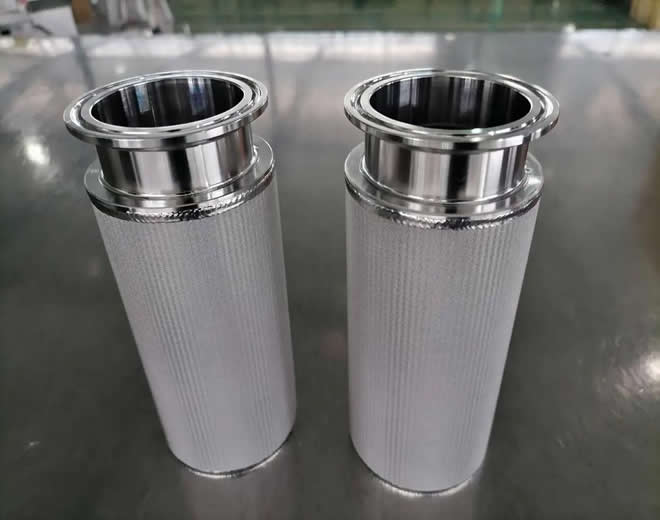
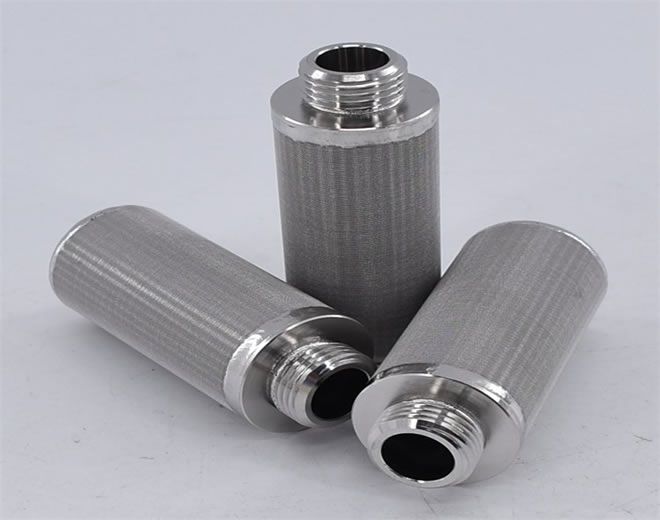
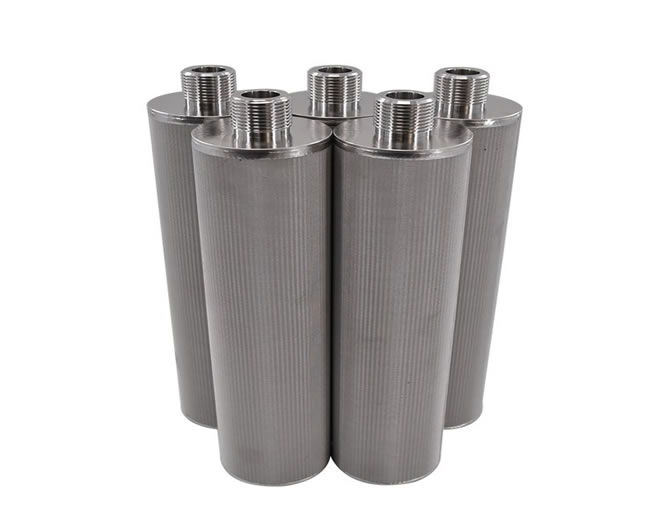
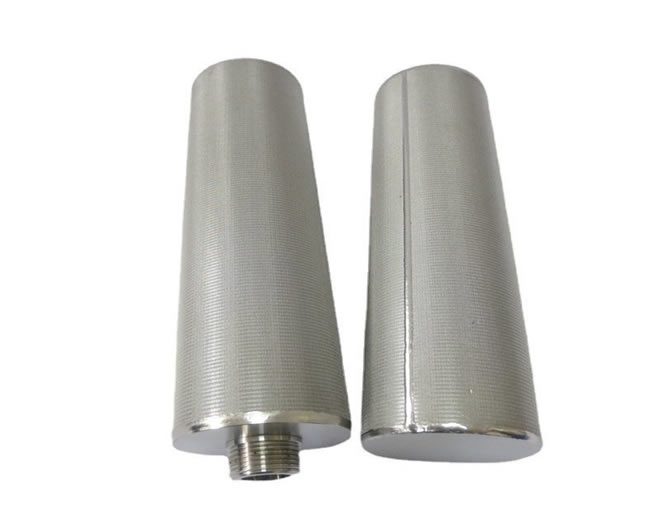
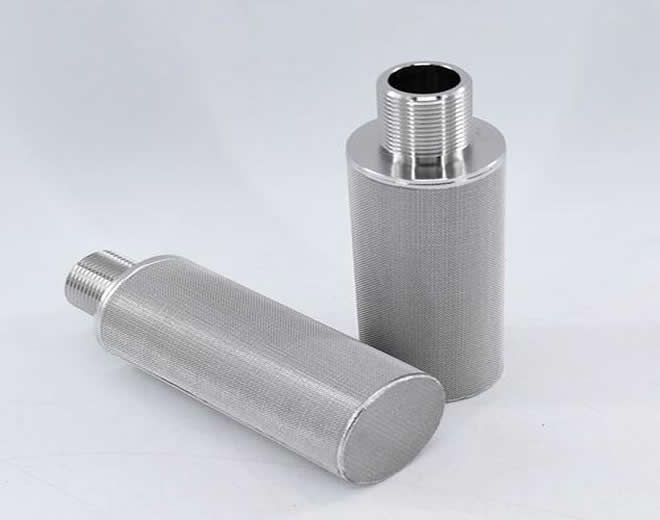





A five-layer sintered wire mesh filter element is a high-performance, porous industrial filtration component. It is constructed by laminating five distinct layers of stainless steel woven wire mesh in a specific order and then bonding them together through a high-temperature vacuum sintering and calendaring process.
The key differentiator is the sintering process: under high heat (below the melting point), the metal atoms at the contact points between the wire layers diffuse and fuse, creating a single, monolithic, and rigid structure with a strong metallurgical bond, rather than just a physical stack of layers.
The design is a masterpiece of functional gradation, creating a symmetrical, gradient pore structure from the outside (upstream side) to the inside (downstream side):
Layer 1 (Outermost/Upstream): Coarse Protective Layer
Material: A rugged, large-aperture grid (e.g., 16, 24 mesh) with thick wires.
Function: To withstand mechanical impact and intercept large particles. It acts as the first line of defense, preventing large contaminants from damaging the finer internal layers, thereby extending the element's service life.
Layer 2: Transition/Diffusion Layer
Material: A medium mesh (e.g., 40, 60 mesh) plain weave wire cloth.
Function: To distribute flow and provide secondary pre-filtration. It evenly distributes the fluid coming from the protective layer, reducing direct impact on the core filtration layer, and traps mid-sized particles.
Layer 3 (Innermost/Middle): Core Filtration Layer
Material: A very fine, high mesh count (e.g., 100, 200, 400 mesh) plain weave wire cloth with extremely thin wires.
Function: The heart of the element that provides absolute-rated filtration. The mesh aperture of this layer defines the element's nominal filtration rating (e.g., 1µm, 5µm, 10µm). All particles larger than this rating are 100% retained on or near the surface of this layer.
Layer 4: Transition/Diffusion Layer
Material: Symmetrical to Layer 2.
Function: Provides flow distribution and support, protecting the core filtration layer from the downstream side.
Layer 5 (Innermost/Downstream): Coarse Support Layer
Material: Similar to Layer 1—a strong, coarse grid mesh.
Function: To provide immense mechanical strength and support. This is the element's "backbone." It withstands high differential pressures and strong backwashing forces, preventing the delicate core layer from collapsing, rupturing, or fatiguing.
In summary, this symmetrical gradient design (Coarse → Medium → Fine → Medium → Coarse) perfectly balances three critical properties: high dirt holding capacity (handled by the outer layers), high filtration precision (handled by the core layer), and high strength/rigidity (provided by the support layers).
Exceptional Mechanical Strength: Can withstand high operating pressures (up to 1-2 MPa) and even higher burst pressures.
Excellent Cleanability & Reusability: The smooth surface and rigid pore structure allow for highly effective backwashing (air or liquid), ultrasonic cleaning, chemical cleaning, or thermal baking. This gives a very long service life.
Absolute Filtration Rating: Offers a wide range of absolute micron ratings (1 - 100 µm), meaning it will retain 100% of particles larger than its rated size.
High Flow Rate & Low Pressure Drop: The uniform, regular pore channels and high porosity (typically ≥35%) ensure efficient fluid passage with minimal initial pressure drop.
Material Stability: Made from 304, 316, or 316L stainless steel, offering superb corrosion resistance, high-temperature resistance (up to 480°C / 900°F), and no media migration (no shedding).
This element is a critical component in demanding industries where reliability is paramount:
Petrochemicals: Filtering polymer melts (e.g., in spin packs for fibers), catalyst recovery, hot gas filtration.
Aerospace & Hydraulics: Critical safety filtration of jet fuel, hydraulic oil, and lubricants.
Pharmaceutical & Biotech: Sterilizing-grade filtration of process gases, compressed air, water for injection (WFI), and fermentation air.
Food & Beverage: Clarification of beers, wines, edible oils, syrups, and seasonings.
Electronics: Purification of high-purity chemicals (e.g., acids, solvents) and ultrapure water in semiconductor manufacturing.
Nuclear Industry: Coolant filtration.
Environmental Protection: High-temperature dust removal from exhaust gases, recovery of precious metals.
Filtration Rating (µm): Choose based on the size of particles you need to remove (e.g., 1µm, 5µm, 10µm).
Material Grade: Select based on fluid compatibility.
304: General purpose, good corrosion resistance.
316: Better resistance to chlorides and acids (adds Molybdenum).
316L: Superior resistance to intergranular corrosion (low carbon content).
Dimensions:
Outer Diameter (O.D.): e.g., Ø30, Ø50, Ø60, Ø65 mm.
Length (L): e.g., 250, 500, 750, 1000 mm.
End Connections: Must match your filter housing. Common types: Double Open (plain ends), 222/226 Tri-Clamp, or M/Metric threaded ends.
Pressure & Temperature: Ensure the element's ratings exceed your system's maximum operating conditions.
| Feature | 5-Layer Sintered Mesh | Single Layer Wire Mesh | Sintered Powder | Pleated Membrane |
|---|---|---|---|---|
| Strength | Extremely High | Low | Medium-High | Very Low |
| Rating Type | Absolute | Nominal (deforms easily) | Nominal | Absolute |
| Cleanability | Excellent | Good | Fair | Poor (disposable) |
| Dirt Capacity | Medium | Low | High | High |
| Temperature | Excellent (480°C+) | Good | Good | Poor |